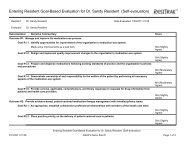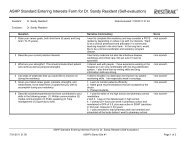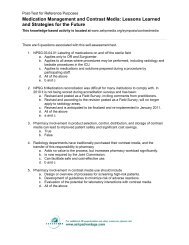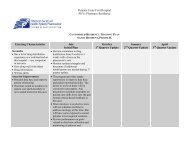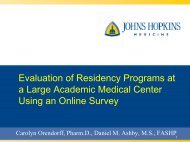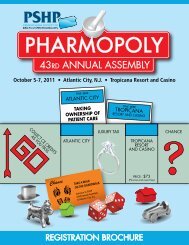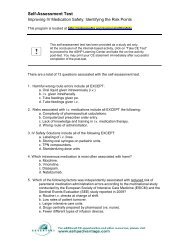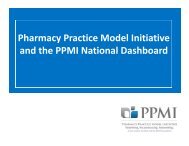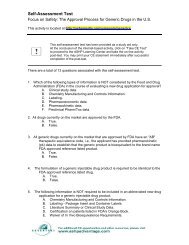Extending Students’ Pharmacy Practice Experiences into Patient-Care Areas
Pharmacy Practice Experiences into Patient-Care ... - Ashpmedia.org
Pharmacy Practice Experiences into Patient-Care ... - Ashpmedia.org
You also want an ePaper? Increase the reach of your titles
YUMPU automatically turns print PDFs into web optimized ePapers that Google loves.
C A S ES T U D Y<strong>Extending</strong> <strong>Students’</strong> <strong>Pharmacy</strong> <strong>Practice</strong><strong>Experiences</strong> <strong>into</strong> <strong>Patient</strong>-<strong>Care</strong> <strong>Areas</strong>Submitted by: Osmel Delgado, Pharm.D., BCPS, cPH, Administrative Director, Clinical Operations, Director of <strong>Pharmacy</strong>Services, Cleveland Clinic Florida, 3100 Weston Road, Weston, Fla. 33331, (954) 689-5283, Delgado@ccf.orgJaime Riskin, Pharm.D., BCPS, Clinical Assistant Professor, Nova Southeastern University College of <strong>Pharmacy</strong>, FortLauderdale, Fla., riskinj@ccf.orgAntonia Zapantis, Pharm.D., M.S., BCPS, Associate Professor, Nova Southeastern University College of <strong>Pharmacy</strong>, FortLauderdale, Fla., zapanta@ccf.org3. Maximize time spent per student experience onpatient-care activities, and4. Reduce student orientation and training time.Relevant PPMI RecommendationsA9. All patients should have a right to the care ofa pharmacist.The Cleveland Clinic team, from left:William Kernan,Pharm.D., BCPS;Antonia Zapantis, M.S., Pharm.D., BCPS;Jaime Riskin, Pharm.D., BCPS; and Osmel Delgado, Pharm.D.,BCPS, cPH (not pictured are Darshika Patel, Pharm.D., BCPS;Martha Espinoza-Friedman, Pharm.D., BCPS; Lori Milicevic,Pharm.D., BCNSP; Diana P<strong>into</strong>, Pharm.D.; Leira Ramirez-Ruiz,Pharm.D., BCPS; and Nathaniel Eraikhuemen, Pharm.D.).Primary Intended Outcomes1. Utilize experiential students as pharmacistextenders to provide extensive drug therapymanagement thus providing a realistic healthsystems experience,2. Expand the experiential program in terms oftypes of experiences and number of students,B23. The following characteristics or activitiesshould be considered essential to pharmacist-provideddrug-therapy management in optimal pharmacypractice models:B23l. Establishment of processes to ensuremedication related continuity of care for dischargedpatients.B24c. Develop a plan to allocate pharmacy studenttime to drug therapy management services.E4. The following are critical components in theimplementation of optimal pharmacy practicemodels:E4n. Training for all pharmacy students on transitionsof care (through collaboration between hospitalsand health systems and colleges of pharmacy).
C A S ES T U D YSituation AnalysisCleveland Clinic Florida (CCF) is a 155-bed academicinstitution located in Weston. CCF has morethan a decade of experience providing introductoryand advanced pharmacy practice experiences(IPPE and APPE, respectively). Four clinical pharmacistswere expected to take a minimum of onestudent monthly. Students were tasked with thepassive observation of clinical pharmacists specializingin nutrition, critical care, infectious diseases,or anticoagulation, practicing in their daily workflow,and engaging in patient case discussions anddrug literature reviews. Limitations of this processincluded the lack of individual computer accessfor students, narrow experiences provided, andminimal responsibility to the services the pharmacydepartment provides.CCF committed to undergo a practice modelchange in August 2011 with the goal of affordingall patients the opportunity for pharmacist interactions.Specialty clinical pharmacists were reassignedto be responsible for all patients withinthe hospital with the overarching principle that“every patient will know who his/her pharmacistis.” In addition to daily responsibilities (patientprofile review, pharmacokinetic and anticoagulationdosing services, patient care rounds, anddrug information provision), pharmacists wouldnow be expected to interact with all patients viathorough medication histories, medication reconciliation,and disease state or discharge medicationcounseling.With the appreciation that the amount of additionalresponsibilities expected of the clinicalpharmacists had potential to be challenged logistically,CCF determined that it would be necessaryto increase students’ patient responsibility, withappropriate training, by utilizing students as pharmacistextenders. This would mean that the numberof available experiences at CCF would need tobe increased. As a result, each preceptor wouldbe expected to offer at least four rotations permonth, and CCF would need to reach out to localschools of pharmacy to seek out additional affiliationagreements. Additionally, in order to efficientlyuse each student and to provide a realistic,more consistent health-system pharmacy experience,CCF began offering a three-month block.Lastly, CCF also collaborated with Nova SoutheasternUniversity College of <strong>Pharmacy</strong> (NSU-COP) and Florida Agricultural and MechanicalUniversity College of <strong>Pharmacy</strong> (FAMU-COP), inorder to obtain three faculty members to furthersupport the practice model change. Facultywould not only provide additional rotations tostudents (hence, broadening pharmacy services),but would also serve to supplement clinical pharmacyactivities and provide support to the currentpharmacy staff in medication safety,education coordination, and research.Service DescriptionDespite having only 155 beds and four clinical pharmacists,CCF has effectively provided a valuableexperience to an average of 15 APPE students permonth since embracing the practice modelchange, with a potential of up to 24 APPE studentsmonthly. Additionally, CCF provides six IPPEs persemester, translating to 1:6 to 1:10 APPE studentto-bedratio and 1:25 IPPE student-to-bed ratio.
C A S ES T U D YStudent experiences focus on integrated clinical(APPE) and distributive (IPPE) patient careresponsibilities. In order to succeed, students areexpected to actively engage in realistic hospitalencounters, an experience that provides the studentwith ample skills to continue a health-systempharmacy career path. Preceptors are taskedwith continual student development, in order toinstruct, model, coach, and facilitate studentresponsibilities with proper evaluation and constructivefeedback.The addition of pharmacist-extenders has successfullyserved to address the needs of every patient.On the first day of rotation (or a rotation block),students are simultaneously oriented as a group byone clinical pharmacist and one faculty member.The orientation process includes the electronichealth record system, documentation practices,medication history and reconciliation processes,and targeted disease-state (heart failure, diabetesmellitus, and COPD) and discharge education. Studentsare also exposed to clinical and drug informationresources. This experience affordsstudents with near full autonomy to provide directpatient care by the second day of rotation, thusmaximizing the experience. Students may haveadditional rotation-specific responsibilities.Student presentations are streamlined, as well.Rather than multiple preceptor-specific journalarticle and topic discussions, students are divided<strong>into</strong> two groups to discuss one article and topicapiece. These presentations are accomplished inonly four hours, monthly. Articles and topics arepre-selected to further enhance pharmacistdevelopment as clinical generalists.Key Elements for Success1. Streamline student orientation/training andactivities.2. Prepare students sufficiently to have independenceas early in the rotation as possible.3. Utilize faculty as education coordinators.4. Provide block rotations.5. Optimize decentralized pharmacy services.Resource UtilizationPersonnel: Although one education coordinatoris desirable (which was accomplished with thehelp of faculty resources), no additional personnelis needed. Faculty also provided additionalpreceptors without added expense.IT and other infrastructure: Students are providedindividual computer accounts and canaccess patient information from any computerwithin the health system. Orientation and computertraining is held in an on-site computer traininglab to allow the students to simultaneouslytrain and customize their accounts.Supply Expense: None.Return on Investment: The pharmacy departmentwas able to reach essentially all patientswithin the hospital. In doing so, patient satisfactionscores have improved, and meaningful clinicalinterventions have increased. Students areable to attend patient-care rounds daily, providinga consistent pharmacy presence. The fundingprovided by the universities for taking studentscan be used toward continuing education and
C A S ES T U D Yother programming to further develop the pharmacistsin both their clinical knowledge as well aspreceptor development.Recognized Intangible BenefitsBy providing students with real-life practical experiences,they can continue to promote the practicemodel changes in future experiences and encourageother institutions to do the same. They canprovide guidance to the practice of utilizing studentsas pharmacist-extenders. <strong>Pharmacy</strong> presencethroughout the hospital developsrelationships and builds rapport, further promotingthe practice model change. <strong>Extending</strong> pharmacyservices to cover all patient areas has thepotential to reduce readmission rates, prevent ormitigate medication errors, and improve patientsatisfaction with pharmacy services. Lastly, thisprogram has provided CCF with a valuable PGY1recruiting tool, as the number of local studentsapplying to our PGY1 program has increased.Outcome MeasuresThe program demonstrated success at the patientlevel with increased patient satisfaction scores(Hospital Consumer Assessment of HealthcareProviders and Systems or HCAHPS), increased volumeand significance of clinical pharmacy interventions,and increased identification of adversedrug events. Additionally, student satisfactiongrew as they became more independent.Lessons Learned1. It’s important to designate a point person tocoordinate educational activities, such as orientationand student presentations. Ideally, thispoint person would be university faculty, ratherthan devoting a full-time employee or expectinga clinical pharmacist to take on the additionalresponsibilities.2. Increasing the number of students who rotatethrough requires additional resources, includingworkspace and computer access. Studentorientation and training is optimal if done simultaneously,which requires a computer lab or alarge conference room. Additionally, formalstudent discussion sessions require access to alarge conference room.3. Preceptors will require additional training inpreceptorship; thus, developmental programmingis a key to success. By opening up therotations to additional students, there is agreater income, which leads to more fundingfor pharmacist education.Other Considerations1. Clinical pharmacists must be willing to take onthe added responsibility of precepting students.2. Students must be able to operate independently;an assessment tool would be invaluableto determine readiness to interact withpatients following a brief coaching session.
C A S ES T U D Y3. Residents are another form of pharmacistextenders,in that they can also serve to precept,mentor, and set examples for thestudents to allow the clinical pharmacists tocontinue to adequately perform their tasks.4. Ideally, students would apply for the threemonthblocks to filter out those students whowould be less able to perform these activities.Suggestions for OtherHospitals/Health Systems1. Work with the pharmacy staff to achieve buy-in.Students may be considered a burden to thoseuninterested or uninformed of their value.2. Work with students during orientation andtraining in order to have student buy-in. Studentsmust realize the responsibility they have,and preceptors must hold them accountablefor patient care. Methodical orientation willprepare students for patient care responsibilitiesand avoid negative experiences.3. Interprofessional collaboration will improvepharmacy relations and further provide valuableinteractions for students.4. Grant students access to the necessary druginformation tools and hospital policies to ensurethere is consistent and accurate informationrepresenting the pharmacy department.Helpful References1. Chase P. Rethinking experiential education (ordoes anyone want a pharmacy student). AmericanJournal of <strong>Pharmacy</strong> Education.2007;71(2):article 27.2. Flynn AA, MacKinnon GE. Assessing Capacityof Hospitals to Partner With Academic Programsfor Experiential Education. AmericanJournal of <strong>Pharmacy</strong> Education. 2008;72(5): article116.



